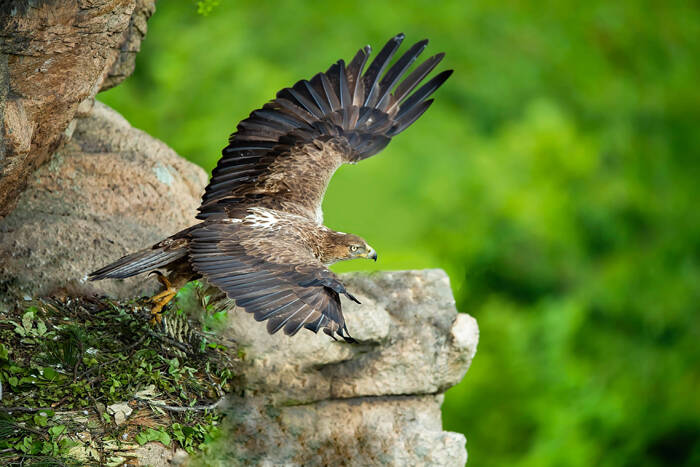Aquila fasciata
IUCN
LCBasic Information
Scientific classification
- name:Aquila fasciata
- Scientific Name:Aquila fasciata,Bonelli's Hawk Eagle,White-bellied Mountain Eagle
- Outline:Raptor
- Family:Falconiformes Accipitridae Falconiformes
Vital signs
- length:70-74cm
- Weight:1.5-2.525kg
- lifetime:20-70years
Feature
They often fly at low altitudes and make sharp calls.
Distribution and Habitat
Distributed in Afghanistan, Albania, Algeria, Bhutan, Bosnia and Herzegovina, Bulgaria, China, Croatia, Cyprus, Djibouti, Egypt, France, Georgia, Gibraltar, Greece, India, Indonesia, Islamic Republic of Iran, Iraq, Israel, Italy, Jordan, Kuwait, Lao People's Democratic Republic, Lebanon, Libya, Macedonia, Mauritania, Montenegro, Morocco, Myanmar, Nepal, Oman, Pakistan, Palestine, Portugal, Saudi Arabia, Serbia, Spain (Canary Islands - migratory bird), Syrian Arab Republic, Tajikistan, Thailand, East Timor, Tunisia, Turkey, Turkmenistan, United Arab Emirates, Uzbekistan, Vietnam, Yemen.
Migratory bird: Austria, Bangladesh, Belgium, Czech Republic, Denmark, Germany, Hungary, Kazakhstan, Kyrgyzstan, Luxembourg, Mongolia, Netherlands, Romania, Slovakia, Sri Lanka, Sweden.
Origin uncertain: Azerbaijan.
In China, it is mainly distributed in the Yangtze River and its south. It is found in Anshun, Wangmo, Guizhou, Hubei, Feixi, Anhui, Ningbo, Wenzhou, Longquan, Zhejiang, Guangxi,
Appearance
The upper body is dark brown, and the top of the head and back of the neck are tan. The feather edges on the sides of the neck and shoulders are gray-white, the flight feathers are gray-brown, and there are cloud-like white spots on the inner feathers. The gray tail feathers are longer, with 7 less obvious dark brown wavy spots and broad black subterminal spots. The lower body is white with light chestnut brown stains. When flying, the underwing coverts are black, and the underside of the flight feathers are white with wavy dark horizontal spots, which are very eye-catching with the white underbody and wing edges.
The iris is light brown, the mouth is blue-gray, the tip is black, the base is gray-yellow, the wax film is yellow, the toes are lemon yellow, and the claws are black.
Size measurements: body weight ♂1500-2100g, ♀1936-2525g; body length ♂270mm, ♀678-730mm; bill peak ♂35-36mm, ♀35-39mm; wings ♂497-515mm, ♀ 465-560 mm; tail ♂270-288 mm, ♀282-314 mm; tarsometatarsus ♂113-1
Details
Bonelli's Hawk Eagle is a large bird of prey with two subspecies: 1. Hieraaetus fasciatus fasciatus distributed in northwest Africa, Iberian Peninsula, Mediterranean, Asia, Arabian Peninsula, Afghanistan, Pakistan, India, Indochina and southern China. 2. Hieraaetus fasciatus renschi distributed in western Somba, East Timor, Weta, Luang Prabang and Lesser Sunda Islands.

The white-bellied falcon eagle lives in mountainous areas, hills and places with abundant water sources. In the mountainous areas of Fujian, China, young birds that have just left the nest can be seen in early August. In Feixi, Anhui, female young birds of the year were collected in November. It uses branches and leaves to build nests on tall trees or cliffs. The breeding season is from March to May. It nests on cliffs or trees on the banks of river valleys. The structure of the nest is relatively large, mainly composed of dead branches, with a few twigs inside. Each nest lays 1-3 eggs, usually 2. The eggs are oval in shape, white in color, generally without spots, and some have a few yellow-brown spots at the blunt end. The parents take turns to incubate the eggs, and they are very protective of the nest. The incubation period is 42-43 days. The chicks are late-maturing, and when they are just hatched, they are covered with white down feathers. They are fed by the parents together for about 60-80 days before their feathers are full and they leave the nest.
In March 2022, scientific research and monitoring personnel of Shennongjia National Park recorded the white-bellied falcon eagle in Dajiu Lake, an internationally important wetland. It is listed in the 2016 Red List of Endangered Species of the World Conservation Union (IUCN) ver3.1-Least Concern (LC).
Listed as endangered species in Appendix II of CITES of the Washington Convention.
Listed as a Class II key protected animal in China;
Listed as a rare species in the China Red Book of Endangered Animals·Birds.
Listed as Class II in the List of National Key Protected Wildlife in China.
Protect wild animals and eliminate game.
Maintaining ecological balance is everyone's responsibility!








